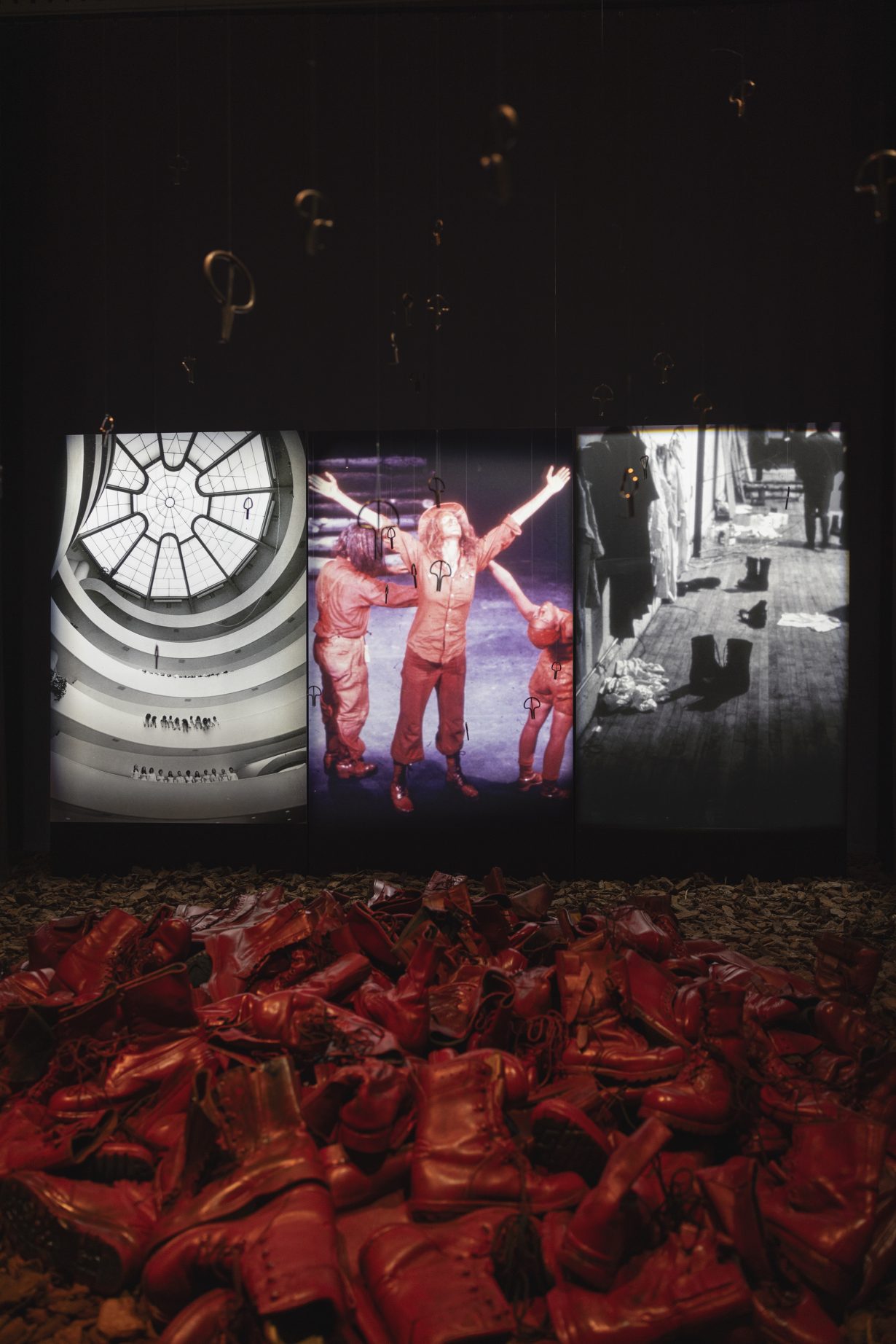Calling at Haus der Kunst, Munich draws attention to the artist’s genre-defying practice, positioning her sound compositions in conversation with theatre, film and dance
Meredith Monk’s practice is synonymous with sound. During her six decade career, the American artist has used her voice as an instrument, stretching its expressive potential without using recognisable words or language, often layering it polyphonically with the voices of others. Her interdisciplinary practice, however, is less well known. Influenced by her childhood studying eurhythmics – a technique teaching rhythm, structure and musical expression through movement – and an interdisciplinary degree at Sarah Lawrence College, Monk often positions her compositions in conversation with theatre, film and dance, creating immersive gesamtkunstwerks in the process. Drawing attention to her genre-defying practice is a key motivation behind her retrospective Calling (the other half of which is concurrently on view at Oude Kerk, Amsterdam).
In Munich, Monk’s most familiar, multilayered musical works are deferred until the final room’s immersive listening environments. There, for example, Dolmen Music (1981), from an album of the same name, her fourth, plays through a circle of headphones that dangle above silver flooring, the circular setup evoking how Monk’s performers originally performed it. Though light and noises seep in distractingly from the rest of the show, Dolmen Music’s cacophony of powerful, vibratory, overlapping and multidirectional voices, from cricketlike chirps to deep-voiced monastic scales, still impresses. It’s a perfect example of Monk’s pioneering use of unintelligibility to transcend language barriers and express universal human experiences; here lamentation and grief come to mind.
That sound’s relationship to space and the human body has always been a keen focus of Monk’s is evident in Calling’s first room, which displays various experimental works from 1966 to 1979 that embrace choreographic and site-specific elements. A standout is a 1977 video of Monk’s multidisciplinary company The House performing Quarry in New York: in an opera meditating on the Second World War and recurring cycles of intolerance through history, Quarry’s ‘March’ section sees the cast execute athletic lunges and militarily precise reaches, their aggressive chants bringing to mind fascist rallies. This choreographic intricacy is emblematic of Monk’s polymathy, and how the danced sections of her works are just as important and developed as the sung. Before she and the likes of her sometime collaborator Merce Cunningham, choreography was often seen as secondary and responsive to audible stimulation. Yet in works like Quarry, sound and movement are equal forces that arise from the human body. Like her languageless compositions, Monk’s choreography reveals the body’s endless potential for nonverbal communication.

Elsewhere in the first room, innovative curatorial setups reflect Monk’s experimental spirit while evoking some of her most seminal works. Juice: a theatre cantata in three installations (1969) is represented through an installation hidden behind a wall of horizontal logs. Peering through the gaps between them reveals the cast’s red combat boots atop a bed of woodchips. Above hang metal keys used in the work, while behind are documentary images from its three iterations: at New York’s Guggenheim Museum, in Barnard College’s Minor Latham Playhouse and in Monk’s loft in Lower Manhattan. A wall text explains how performing Juice in sequentially smaller locations didn’t just cement Monk as a pioneer of site-specific works; it also helped her create ‘a dialogue between how space affects images and time’. Each iteration reimagined the relation- ship between performers and the audience. What was incrementally lost in monumentalism (eg a live horse at the Guggenheim became a toy replica in later versions) was made up for in intimacy. As I observe the scene presented in Calling, smell the fragrant woodchips and listen to a recording of the original cantata on headphones, this Juice feels like peak intimacy – the performance takes place in the viewer’s mind, assembled via connected traces and remnants.
That closeness is reinforced by Calling’s second room, a replica of Monk’s live/work loft in New York. Surrounding a central piano and four-track tape recorder, the walls are lined with shelved books, handwritten notes, personal photographs with the likes of Björk, John Cage and the Dalai Lama, and examples of Monk’s unique approach to movement and voice notation in which large, gestural pencil strokes (as opposed to codified musical notes) represent her scores. Interacting with Singing Suitcases (1998/2003) series, battered trunks that release a vocal composition when opened, feels like rummaging through boxes in the artist’s apartment, uncovering the past. Such echoes paint a vivid portrait of Monk as a person and artist, yet the full picture of her output (and a clear chronology of it) remains just out of reach. Numerous videos – some performance documentations, others filmic artworks created for screen – help viewers judge the success of their detective work, yet many may induce longing if you weren’t around to witness Monk’s original live performances. It’s a positive melancholy, however: by presenting ‘monuments’ to performance rather than attempting to substitute for it, Calling exhibits a radical acceptance of the artform’s ephemeral nature.
Calling at Haus der Kunst, Munich, through 3 March
